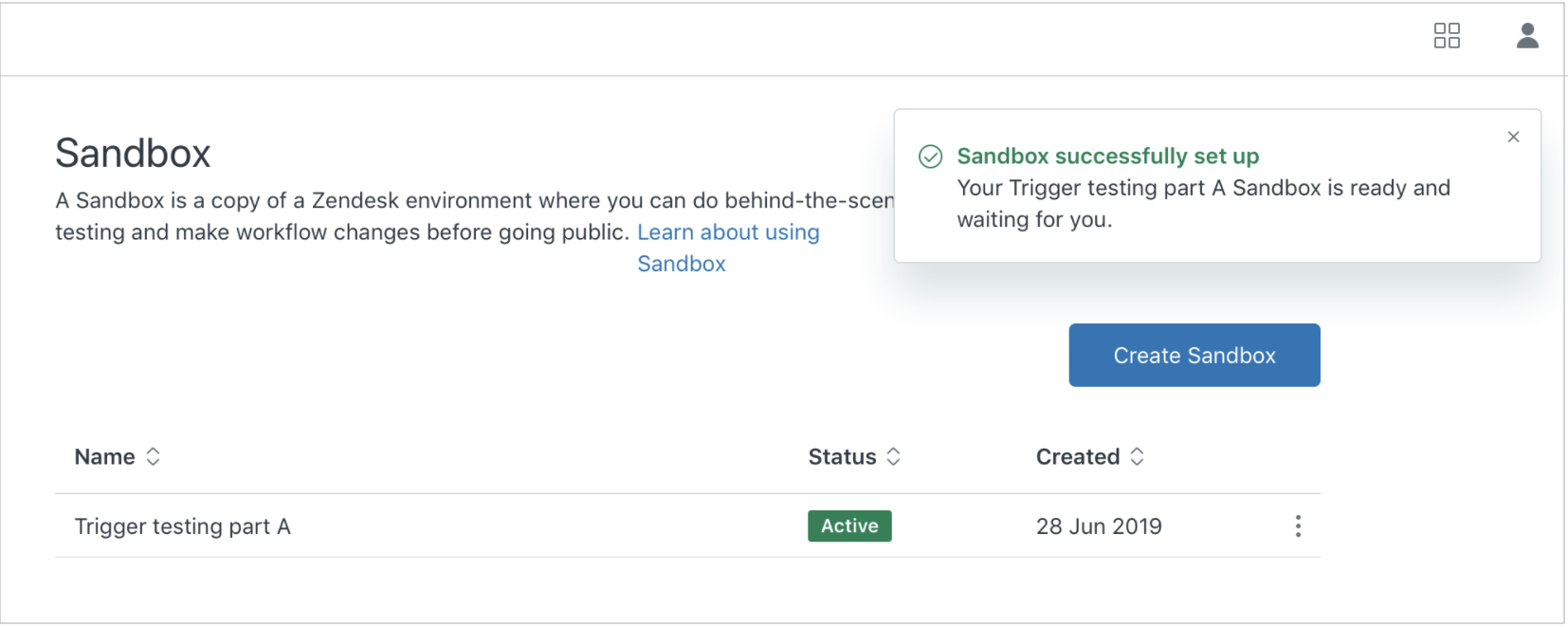Premium sandbox provides a test environment that closely mirrors your production instance in configuration and, potentially, data. This allows you to accurately test updates to workflows, experiment with integrations, and provide training for new agents in an environment that closely mirrors the production environment.
This article contains the following topics:
Premium sandbox overview
- Support Enterprise includes one standard sandbox.
- Suite Enterprise includes one standard sandbox and one partial premium sandbox.
- Suite Enterprise Plus includes one standard sandbox and one full production premium sandbox.
Additional premium sandboxes can be purchased as an add-on.
- Brands
- Dynamic content
- Ticket fields
- Ticket forms
- User fields
- Organizations (only organizations referenced in configurations and tickets for express sandboxes)
- Organization fields (only for organizations referenced in configurations and tickets for express sandboxes)
- Targets (set to inactive in the sandbox by default)
- Groups
- Custom roles
- Shared views
- Shared macros
- Triggers
- Trigger categories
- Automations
- Agents
- Group memberships
- Support addresses (Internal support addresses, such as help@mybusiness.zendesk.com, are copied with slight modification to contain the brand's unique subdomain within the sandbox. If you've configured external support addresses, such as help@mybusiness.com, they're converted to internal addresses when replicated to a sandbox using the following structure: help-at-mybusiness-com@sandboxsubdomain.zendesk.com. If you've set an external support address as the default, the sandbox reverts to using the original default internal address: support@mybusinesssandbox.zendesk.com.)
- Webhooks (set to inactive in the sandbox by default)
- Apps (only free Marketplace apps that don't require authentication or additional configuration at installation)
- Custom objects (this doesn't include custom object records, lookup fields related to custom objects, or legacy custom objects)
For more information about data replication, see About Zendesk sandbox environments. To understand exactly what data was and wasn't successfully replicated for a particular premium sandbox, see Generating a creation report for a premium sandbox.
Additionally, it is possible to update existing sandboxes to reflect subscription changes to Zendesk products and add-ons. No other data can be updated after a sandbox is created. See Syncing product and add-on data to sandboxes.
Creating a premium sandbox through replication
Replication occurs automatically when you create a premium sandbox through Admin Center. The replication retrieves data from the production instance and creates the configuration and content in the sandbox, creating a new subdomain. The process will not affect the performance of your production instance. Data is only retrieved from the production instance, so nothing will be added, updated, or deleted there. For a complete list of the data that is replicated, see Understanding premium sandboxes.
The configuration of your sandbox instance will change rapidly while the replication is occurring, so we recommend waiting to use it until the replication completes. The time it takes for a replication to complete varies depending on the amount of content involved. A simple metadata copy with a small amount of fields and business rules takes less time, ranging from a few minutes to a few days. A full copy with 100,000 tickets and the related users and organizations can take up to a week or more to complete. When the replication is complete, the status of the sandbox changes to Active.
To create a premium sandbox
- Before creating a new sandbox, make sure you've configured a default group for your account.
- In Admin Center, click
 Account in the sidebar, then select Sandbox > Sandboxes.
Account in the sidebar, then select Sandbox > Sandboxes. - Click the Create Sandbox button.
- Enter a Name that describes your sandbox.
- Select your preferred sandbox to set up. You can only select sandbox types that
are available in your plan or that you've purchased as an add-on.
- Standard Sandbox - A standard sandbox with none of your settings, business rules, or tickets.
- Premium Sandbox - Metadata - A copy of your production settings and business rules, but no tickets
- Premium Sandbox - Partial / Production - A copy of your production settings, business rules, and tickets.
- (Optional) When creating a premium sandbox, you can choose to Enable express
sandbox, which copies only organization data referenced in your
configurations, such as business rules and tickets.
The more organizations you have, the longer it takes to replicate your data when creating premium sandboxes. This option is recommended if you have 100,000 organizations or more. For example, if you have two million organizations, creating a premium partial or production sandbox could take four days, whereas creating it as an express sandbox could reduce that time to hours.
- If you selected Premium Sandbox - Partial / Production, you must also
select the number of tickets to copy to the sandbox.
- Up to 10,000 tickets - The maximum number of unclosed tickets you can copy with the Zendesk Suite Enterprise plan. This is referred to as a partial copy.
- Up to 100,000 tickets - The maximum number of unclosed tickets you can copy with the Zendesk Suite Enterprise Plus plan. This is referred to as a full production copy.
- Click Create.
You will see a message that your sandbox is being created. When your sandbox is successfully created, a message appears at the top of the page, and the status of the sandbox becomes Active. The sandbox has a unique URL with a ten-digit number after your domain name.
You can access a creation report for 30 days following the creation of a premium sandbox. This report contains details about most of the production data that Zendesk attempted to replicate in the sandbox, including explanations for anything that failed to replicate. See Generating a creation report for a premium sandbox.
With your newly-replicated sandbox, you will have an environment that closely mirrors your production instance. This enables you to test out new workflows, give your agents a safe place to train, and provide a high-quality environment for development purposes. See Managing premium sandboxes.


46 comments
Sign in to leave a comment.